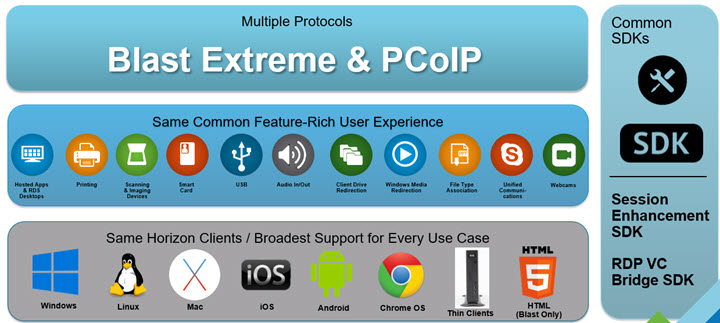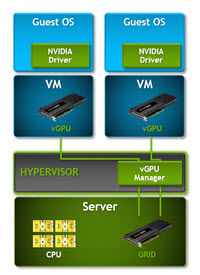It's been this month that there has been a release of VMware Horizon View 7.4. In case you're lost in the release numbers, don't worry. You're not alone. There have been quite a few releases of VMware Horizon recently, but this one allows creating Instant-Clone Floating Desktop Pool for Linux desktops.
The long-term goal from VMware is to provide access to desktop pools from any device. They're getting there. The VMware Blast Extreme technology with adaptive transport has significant advantages compared to its predecessors. It dynamically adjusts to varying bandwidth, latency and packet loss.
VMware Blast uses standardized encoding schemes (JPG/PNG and H.264 for pixel encoding), and Opus for audio. Those standard formats are supported natively, and are more efficient, by displaying the media in browsers and mobile devices.
What's new in Horizon View 7.4?
Horizon Connection Server
- Cloud Pod ArchitectureThe Cloud Pod Architecture feature now supports one-way Active Directory trust domains. Horizon administrators can implement one-way trust topologies in a Cloud Pod Architecture environment, and end-users can select and launch remote desktops and published applications across the trust.
- Users can now launch remote desktops and applications on a later version pod when connected to an earlier version pod in a Cloud Pod Architecture environment.
You can enable the Session Collaboration feature for global desktop entitlements. - Published Desktops and Application PoolsYou can use NVIDIA GRID vGPU for 3-D rendering when you create an instant-clone farm.
The “Empty session timeout (applications only)” option provides a new “immediate” timeout value in the farm settings to log off the session when the last application window is closed.
Horizon Agent for Linux
- Instant-Clone Floating Desktop Pool – You can create a Linux-based instant-clone floating desktop pool with Horizon 7 Agent for Linux. This feature is supported only on Ubuntu 14.04 and 16.04 systems.
- Active Directory Integration with PBISO. – Linux-based desktops are allowed to authenticate with Active Directory using PowerBroker Identity Services Open (PBISO). This feature is supported only on Ubuntu 14.04 and 16.04 systems.
- 3Dconnexion Mouse – The 3Dconnexion mouse support is available in Horizon 7 Agent for Linux using USB redirection.
- Additional platform – SUSE Linux Enterprise Server 12 SP3 and SUSE Linux Enterprise Desktop 12 SP3 are supported.
Horizon Agent
- Session Collaboration – With the Session Collaboration feature, users can invite other users to join an existing remote desktop session.
- Fingerprint Scanner Redirection by Using the Device Bridge BAS Plugin – You can redirect biometric devices, specifically fingerprint scanners, that are plugged into a serial port on a Windows client system to virtual desktops, published desktops, and published applications by using the device bridge feature. You can install the Device Bridge BAS Plugin by selecting the Device Bridge BAS Plugin custom setup option in the Horizon Agent installer.
- Secure boot enabled machines supported with URL Content Redirection – URL content can now be redirected from machines that have secure boot enabled.
- URL Content Redirection with Chrome – URL content can now be redirected in the Chrome browser. Both agent-to-client and client-to-agent redirection are supported. To use this feature, the VMware Horizon URL Content Redirection Helper extension must be installed and enabled in Chrome.
Horizon GPO Bundle
- Configure Session Collaboration group policy setting – Use the Collaboration group policy setting in the VMware View Agent Configuration ADMX template file (vdm_agent.admx) to configure Session Collaboration on remote desktops.
- Device Bridge BAS Plugin group policy setting – Use the Disable Device Bridge BAS Plugin group policy setting in the VMware View Agent Configuration ADMX template file (vdm_agent.admx) to disable the Device Bridge BAS Plugin.
- Server clipboard memory size group policy settings for VMware Blast and PCoIP – Use the Clipboard memory size on server group policy setting for VMware Blast sessions, and the Configure clipboard memory size on server for PCoIP sessions, to specify the server's memory size value for clipboard redirection in bytes or kilobytes. The VMware Blast setting is in the VMware Blast ADMX template file (vdm_blast.admx). The PCoIP setting is in the PCoIP ADMX template file (pcoip.admx).
- H264 High Color Accuracy – The VMware Blast setting in the VMware Blast ADMX template file (vdm_blast.admx) increases color accuracy when using H.264 encoding by using the YUV 4:4:4 colorspace instead of 4:2:0.
The Horizon Administrator user interface, Horizon Administrator online help, and Horizon 7 product documentation are available in Japanese, French, German, Spanish, simplified Chinese, traditional Chinese, and Korean.
VMware Horizon 7.0 was a major release of the product. Here are few highlights of what has been added.
Blast Extreme
Optimized for mobile. All existing Horizon View remote features work with Blast extreme and latest horizon 4 clients. Blast extreme has lower requirements on bandwidth.

Blast extreme is optimized for NVIDIA GRID allowing very good graphics even on lower cost PCs allowing better frame rate, higher server scalability, reduced latency or better bandwidth optimization . Allows up to 4K resolution !!!
. Allows up to 4K resolution !!!
- Supports NVIDIA GRID K1, K2, M6 and M60 graphics cards
- H.264 encoder option on NVIDIA GRID GPUs to lower CPU consumption and increase scalability
- VMware Identity Manager Integration – Identity manager is integrated with CPA, where it will present the desktops or applications available from any CPA Pod.
- Instant Clones details – the vmFork technology. Instant Clones leverage VMware vmFork technology where a running, powered on a desktop (Parent Virtual Machine) is quiesced and cloned. The clone shares the disk and memory of the Parent VM for reads – space and memory efficiency. The guest OS is customized, joins the domain, and is ready for user login as the desktop fully powers on.
Instant Clone (aka VMfork) technology
It uses a copy-on-write architecture similar to that of containers, meaning that if an application running in a child VM tries to change a shared OS file, a copy of the shared file is created and stored in the child VM.
This way, all modifications made by the VM are isolated and unique only to it. Any newly created files that are saved by the VM would also be stored in the child VM and not in the parent.
The release before the 7.4 was the 7.3.1 and it brought Horizon Help Desk tool – integrated help desk utility allowing to display applications process resources with reset control. Has a Role-based access, activity logging, shows horizon client info, has a granular logon time metrics. Also, the tool shows Blast Extreme display protocol metrics.
Download Horizon View Here, full release notes here.
More from ESX Virtualization
- What is VMware Instant Clone Technology?
- VMware Horizon 7 Reviewer’s Guide
- VMware vSphere Standard vs Enterprise Plus
- Migration Of Windows 7 To Windows 10 Using VMware Mirage?
- VMware Mirage Architecture Preparation Steps
Stay tuned through RSS, and social media channels (Twitter, FB, YouTube)

